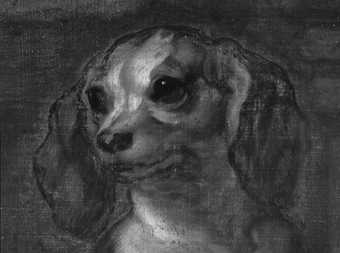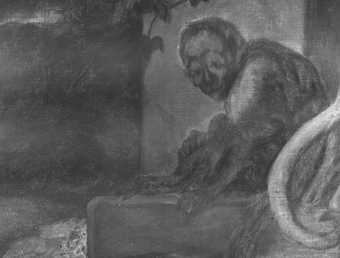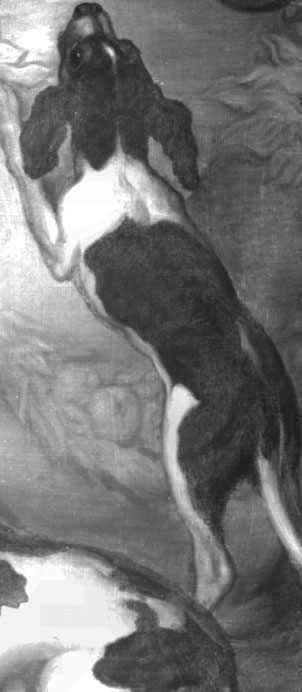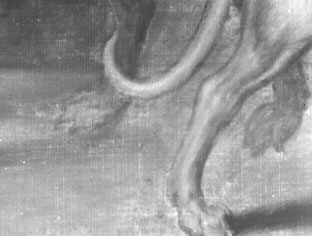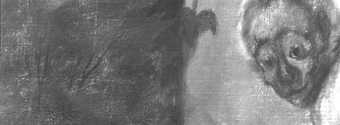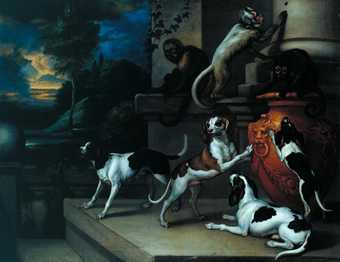
Fig.1
Francis Barlow
Monkeys and Dogs Playing 1661
Oil paint on canvas
1055 x 1320 mm
T05572
This painting is in oil paint on canvas measuring 1055 x 1320 mm (fig.1). The support is a single piece of fairly coarse, plain woven linen with a weave count of 13 vertical and 11 horizontal threads per square centimetre. The threads are of uneven thickness with many slubs. Cusping around the edges indicates that the painting has not been reduced in size, although it has lost its tacking edges (fig.2).1 Bar marks in the painting indicate that the original stretcher or strainer was a simple rectangle.

Fig.2
X-radiograph of Monkeys and Dogs Playing
The ground is yellowish-buff colour. It is composed of a thin, single layer, which does not quite fill the interstices of the weave, though this effect may have been exaggerated by lining. It is rich in marine chalk with additions of lead white, bone black and ochre.2 Red lead in the samples from the ground can be attributed to the formation of lead soap aggregates, which have developed as the lead white has aged and altered in composition.3
Infra-red examination did not reveal any underdrawing, but showed that the dogs had been laid in with a thick, boldly applied black underpaint. This underpaint sometimes plays an optical part in the finished painting, providing shadows to the forms. In the white chest of the right-hand dog, the dark underpaint lends a blue tone to the painted surface through the turbid medium effect. This is an optical phenomenon whereby dark marks lying beneath a layer of light-coloured, semi-opaque paint will appear as cool, pearly tones of the overlying colour. The monkeys, by contrast, were not underpainted in this way but had reserves left for their inclusion in the background composition (figs.3−9). This lends weight to the idea that the dogs were painted from life to provide portraits for their patrons, while the monkeys – one of which appears identically posed in an engraving of a Barlow – are more likely to be standard studio patterns. The only pentimento discovered was a small change to the shape of the back of the monkey crouching on the urn. This is painted over the column.
The paint was applied wet-in-wet with small, smooth brushes for the animals and with larger, stiffer ones in the background. There is virtually no impasto except perhaps for the spots of light in the animals’ pupils. All the darks are semi-translucent, making use of the warm-coloured ground lying beneath them to create a sense of depth and richness. The pigments are fairly coarse and of good quality. The mid-tone of the red urn was mixed from lead white, burnt sienna, vermilion, indigo, lead tin yellow, red lake, bone black and pipeclay. Bluish green from the distant tree was composed of azurite, black, yellow ochre, smalt and some vermilion. Blue distant hills were made from lead white, azurite, smalt, Cologneearth, yellow and red ochres and calcium carbonate (chalk). Greyish blue sky paint is a mixture of lead white, smalt, black, ochre, gypsum and a trace of vermilion. Dark black paint from a dog contained bone black, lead white, talc and smalt. Black pigments were used extensively and are found as an admixture in almost every paint passage, including the whites. Likewise, blue pigments are widespread in the composition and are included in small amounts in the grey background.
The painting is worn in the thinly painted areas. It seems that this may be due to the vulnerability of the ground layer, which seems soft and friable. The painting has a glue-paste lining, probably done in the nineteenth century. It was cleaned and restored shortly before being acquired by Tate in 1989. The current varnish is a modern synthetic resin.
2005

